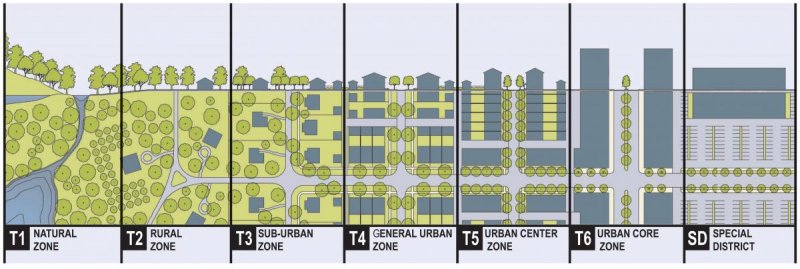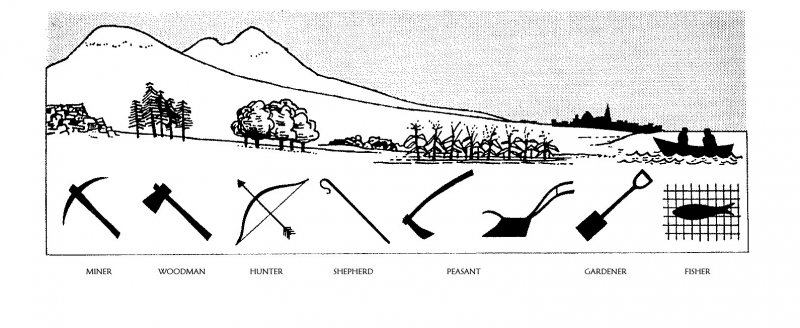Planopedia
Clear, accessible definitions for common urban planning terms.
What Is New Urbanism?
New Urbanism is one of the most influential planning and urban design reform movements of recent decades.

Definition
New Urbanism is arguably the most recognizable planning reform movement of the last few decades of the 20th century and into the present day, rivaling the most influential planning movements of modern history.
The primary motivation of New Urbanism is to offer an antidote to the proliferation of sprawling, suburban environments, defined by characteristics like auto-dependency, the separation of uses, and a uniformity of single-family detached housing. The vision of community proffered by New Urbanism is defined by smaller homes, narrower streets, a mix of uses, and neighborhood amenities accessible by foot or bike, among many other nuanced characteristics.
According to the proponents of New Urbanism, the movement is responsible for reintroducing Americans to the concepts of urban living, by presenting an alternative to suburban sprawl inspired by the planning and design principles of urban development before the dawn of the automobile. The term frequently used to describe New Urbanism's adherence to historic development principles is traditional neighborhood developments, or TNDs.
While New Urbanism trades on ideas about the characteristics of more urban environments, these principles have also been used to create entirely new communities from scratch in suburban areas of metropolitan regions. While the characteristic developments of New Urbanism will blend into many existing urban environments, TNDs are much more conspicuous when built into a community from scratch, like in some of the case studies mentioned below.
The intended benefits of New Urbanism vary, in either case, but they always include increased economic, physical, and social activity. To achieve those benefits, New Urbanism focuses on the connections between private and public spaces with prescriptions for features like frontages (i.e., the space between the building and the curb of the street), façades (e.g., the exterior skin of buildings), and even the number and positioning of doors and windows on the buildings, among other considerations. New Urbanism integrates design into the regulations of planning in the belief that these kinds of choices will create urban spaces that will better attract housing and jobs and also make cities more hospitable to pedestrians and bikes and far less dependent on automobiles. To put it more succinctly, New Urbanism believes that the proper design and planning of the private realm can create an ideal public realm.
Big Ideas
Over the years, the core tenets of New Urbanism have inspired a number of subsidiary causes. Key terms used to describe the activity of planning and designing according to New Urbanism include placemaking, incremental development, and the rural/urban transect, to name just a few examples. Form-based codes, hybrid codes, tactical urbanism, and Missing Middle Housing can be traced to origins in the New Urbanism movement, and New Urbanism also plays an influential role in the ongoing debates regarding fundamental questions of contemporary planning, like transportation planning (from the hyper local to the regional level), housing affordability, and growth management.
The practical embodiment of New Urbanism, and its most obvious and specific legacy, are form-based codes, which have been implemented in cities around the country to focus development regulations on the form and type of buildings. Traditional zoning codes have focused on the activities inside the planned buildings, so the focus of form-based zones on the form and type of buildings represents a significant reform of the regulatory power of planning.
For more information on form-based codes, see also the Project for Code Reform and the "Users Guide to Zoning Reform."
Another of one of the most obvious and specific signifiers of New Urbanism is the Urban/Rural Transect, which is an infographic that presents a spectrum of development patterns to illustrate the defining characteristics of each environment from rural to urban.

Transect graphic, by DPZ via the Congress for the New Urbanism.
The Rural/Urban Transect has been elevated in the planning discourse since New Urbanists began championing the concept, but the idea of the transect goes back to "Valley Section" created by Patrick Geddes in 1909.

The Valley Section, by Patrick Geddes.
Institutions and Principals
One of the defining characteristics of New Urbanism is its institutions, which coalesce around an organization called the Congress for the New Urbanism (CNU). CNU has thousands of members—perks of membership include an annual conference, professional certification, and numerous local and regional chapters. CNU has a charter, budget, staff, and a headquarters in Chicago. The Charter of the New Urbanism sets out a specific vision for American regions and cities based on the reform of sprawl. Thus, New Urbanism can be described as more formally and overtly political than general urbanism and even the larger professional field of planning.
CNU was founded in 1993 by Andrés Duany, Elizabeth Plater-Zyberk, Stefanos Polyzoides, Elizabeth Moule, Peter Calthorpe, and Dan Solomon—who now all hold lofty positions in the constellation of the most influential planners and designers to ever build cities.
New Urbanists also give credit to the writings of Léon Krier, Jane Jacobs, and Christopher Alexander for the inspiration that informs the doctrine laid out in the CNU Charter.
Case Studies
New Urbanism has been deployed in planning and design practice for long enough now that it's easy, when describing New Urbanism, to point at a few illustrative examples that clearly embody the principles and spirit of New Urbanism. You know New Urbanism when you see it in some of these master planned communities.
Plum Creek, Texas
- A Study in Texas New Urbanism (Planetizen, January 2009)
Celebration, Florida
- New Urbanism's Economic Achilles Heel (New Geography, October 2008)
- Elizabeth Plater-Zyberk on the Work of New Urbanists (Planetizen, November 2011)
- What Disney’s city of the future, built to look like the past, says about the present (The Economist, December 2016)
Seaside, Florida
- Book Review: Visions of Seaside (Planetizen, January 2014)
Kentlands, Maryland
- Measuring Success At Kentlands (Planetizen, November 2007)
- 25 years later, what can we learn from New Urbanism? (Greater Greater Washington)
Mueller, Austin, Texas
- A Texas Community Takes On Racial Tensions Once Hidden Under The Surface (NPR, February 2015)
Middleton Hills, Wisconsin
- New opportunities for New Urbanism? (The Cap Times, June 2011)
Serenbe, Georgia
- Serenbe (Congress for the New Urbanism)
- Agrihoods Still Proving Popular (Planetizen, August 2017)
Heart of the City, Rochester, Minnesota
- New Urbanism Emerged in Response to Sprawl, but Does it Really Offer an Alternative? (Planetizen, February 2017)
U.S. Department of Housing and Urban Development, Hope VI Design Guidelines
- HOPE VI (Congress for the New Urbanism)





